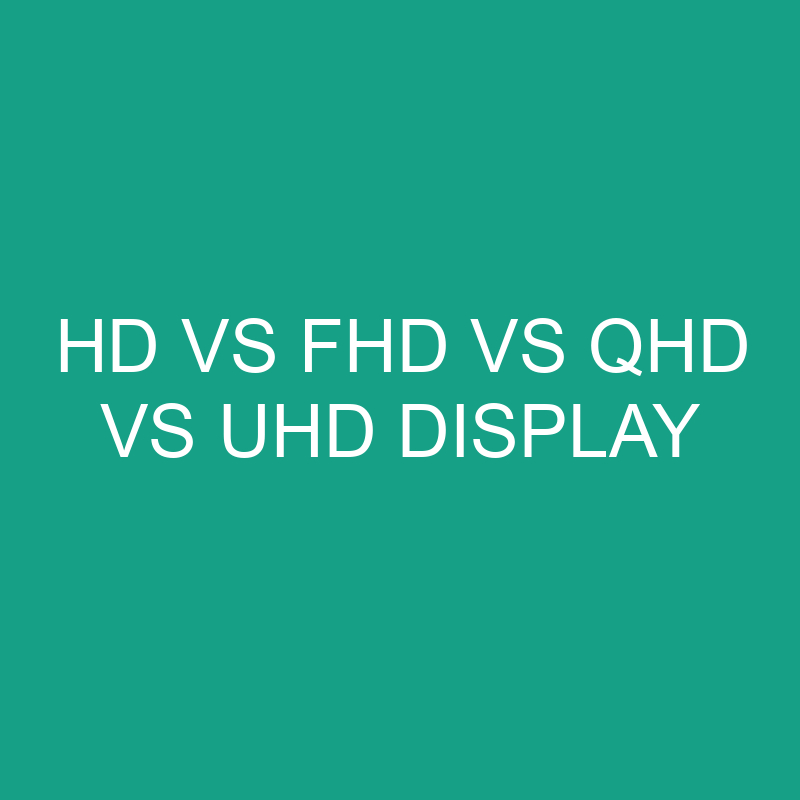In the ever-evolving landscape of display technology, consumers are faced with a plethora of acronyms and terms describing screen resolutions. From the classic HD to the ultra-sharp UHD, each designation represents a different level of visual fidelity. In this comprehensive exploration, we’ll dive into the realms of HD, FHD, QHD, and UHD displays, dissecting their characteristics, benefits, and applications.
Post Contents
High Definition (HD) Display:
Overview:
HD, or High Definition, was a groundbreaking standard that revolutionized visual experiences in the early 2000s. It introduced a significant leap in resolution compared to standard-definition displays, providing sharper images and more detail.
Key Features:
- Resolution: HD typically refers to a resolution of 1280 x 720 pixels (720p) or 1920 x 1080 pixels (1080p).
- Aspect Ratio: The aspect ratio is 16:9, offering a widescreen viewing experience.
- Applications: Widely used in television broadcasts, DVDs, and early-generation smartphones.
Pros and Cons:
- Pros: Improved clarity over standard-definition displays, widespread compatibility.
- Cons: Becoming outdated as higher-resolution standards emerge.
Full High Definition (FHD) Display:
Overview:
FHD, or Full High Definition, took the visual experience a step further by doubling the pixel count of HD. This upgrade translated to even crisper images and enhanced clarity.
Key Features:
- Resolution: FHD has a resolution of 1920 x 1080 pixels (1080p).
- Aspect Ratio: Maintains the 16:9 widescreen aspect ratio.
- Applications: Found in HDTVs, computer monitors, and smartphones, providing a standard for quality visuals.
Pros and Cons:
- Pros: Enhanced visual quality, widely adopted across various devices.
- Cons: Faces competition from higher-resolution standards in premium devices.
Quad High Definition (QHD) Display:
Overview:
QHD, or Quad High Definition, marked a significant stride towards sharper and more detailed visuals. With four times the pixel count of HD, it became a preferred choice for premium smartphones and computer monitors.
Key Features:
- Resolution: QHD typically has a resolution of 2560 x 1440 pixels (1440p).
- Aspect Ratio: Maintains the 16:9 widescreen aspect ratio.
- Applications: Commonly seen in flagship smartphones, high-end computer monitors, and some TVs.
Pros and Cons:
- Pros: Exceptional clarity, well-suited for larger screens, excellent for gaming and multimedia.
- Cons: Demands higher processing power, may impact battery life on mobile devices.
Ultra High Definition (UHD) Display:
Overview:
UHD, or Ultra High Definition, catapults display technology into the realm of breathtaking visuals. With four times the pixels of FHD, it’s the go-to standard for premium TVs, streaming services, and professional monitors.
Key Features:
- Resolution: UHD has a resolution of 3840 x 2160 pixels (2160p) or 4096 x 2160 pixels in the film industry.
- Aspect Ratio: Maintains the 16:9 widescreen aspect ratio.
- Applications: Predominantly used in high-end TVs, streaming services, professional video editing, and gaming.
Pros and Cons:
- Pros: Unparalleled visual fidelity, ideal for large screens, immersive gaming and cinematic experiences.
- Cons: Requires substantial hardware capabilities, premium price tag.
Conclusion:
As technology advances, the visual fidelity offered by displays continues to reach new heights. Choosing between HD, FHD, QHD, and UHD depends on factors such as device type, intended use, and personal preferences. While HD and FHD remain relevant for many applications, QHD and UHD set the benchmark for those seeking cutting-edge visuals. As consumers embrace larger screens and richer content, the demand for higher-resolution displays is likely to persist, pushing the boundaries of what is visually possible.
